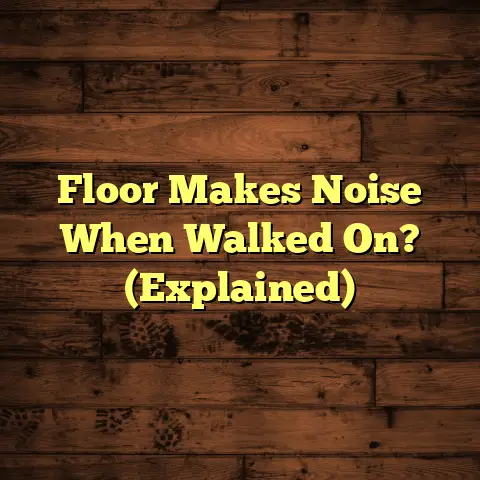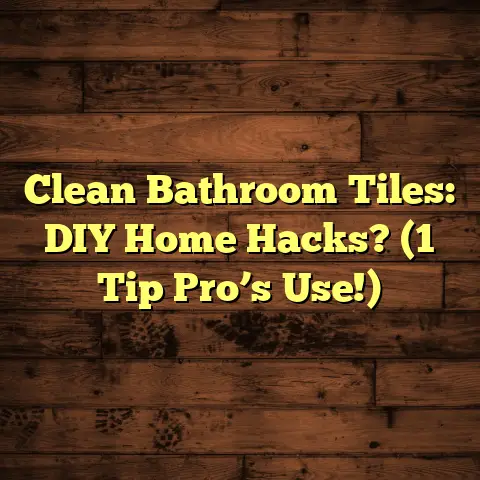Remove Vinyl Tiles? (4 Tools You NEED!)
Ever walk into a room and just feel… blah?
Sometimes, all it takes is a change underfoot to completely transform a space.
Think about it: warm, inviting flooring can make a house feel like a home, a place where you actually want to spend time.
It’s not just about aesthetics, though.
Warm flooring, whether it’s the visual warmth of wood-look planks or the physical warmth under your feet, adds a layer of comfort that makes a huge difference.
I’ve seen it time and time again in my years as a flooring contractor.
Sometimes, the key to unlocking that warmth is removing what’s already there – like those outdated or damaged vinyl tiles.
Ready to ditch the drab and embrace the fab?
Let’s dive in!
Understanding Vinyl Tiles
Vinyl tiles have been a popular flooring choice for decades, and for good reason.
They’re affordable, durable, and relatively easy to install, making them a go-to option for bathrooms, kitchens, and basements.
But what about that “warmth” factor I mentioned?
Well, vinyl itself isn’t inherently warm like a wool carpet.
However, it does have some insulating properties.
It’s better than cold, hard tile, for sure.
Plus, the newer luxury vinyl tile (LVT) and luxury vinyl plank (LVP) options often have a thicker construction and even an attached underlayment, boosting their warmth and comfort.
So, why remove them?
There are plenty of reasons.
Maybe your vinyl tiles are outdated and clashing with your current style.
Perhaps they’re damaged, with cracks, chips, or peeling edges.
Or maybe you’re just ready for a change, a fresh start with a brand-new flooring option.
Whatever the reason, removing vinyl tiles is often the first step towards creating a more inviting and cozy space.
The Importance of Proper Tools
Now, listen up, because this is crucial.
Removing vinyl tiles isn’t rocket science, but it is a task where having the right tools can make or break the experience.
Seriously.
I’ve seen homeowners try to tackle this project with just a screwdriver and a whole lot of frustration.
Don’t be that person!
Using the correct tools isn’t just about making the job easier.
It’s about ensuring a clean and damage-free removal process.
Think about it: you’re working on your subfloor, the foundation for your new flooring.
You don’t want to gouge it, crack it, or leave behind a ton of adhesive residue that’ll make installing your new floor a nightmare.
Plus, let’s be honest, using the wrong tools can be downright dangerous.
Slipping with a dull knife or straining your back trying to pry up stubborn tiles can lead to injuries.
Trust me, a trip to the emergency room is not the kind of transformation you’re looking for.
So, invest in the right tools, learn how to use them properly, and you’ll be well on your way to a successful vinyl tile removal project.
Tool #1 – Utility Knife
Alright, let’s get down to brass tacks.
First up on our list of essential tools is the humble utility knife.
Don’t underestimate this little guy.
A good utility knife is your best friend when it comes to scoring the vinyl tiles and breaking the adhesive bond.
Why a utility knife?
Well, the sharp, retractable blade allows you to make precise cuts without damaging the subfloor.
Plus, you can easily replace the blade when it gets dull, ensuring a clean cut every time.
I recommend using a heavy-duty utility knife with a comfortable grip.
You’ll be doing a lot of cutting, so you want something that feels good in your hand.
Here’s how to use it safely and effectively:
- Always wear safety glasses and gloves. Seriously, protect those peepers and hands!
- Extend the blade just enough to cut through the vinyl without digging into the subfloor.
- Score the tile along the grout lines or in a grid pattern across the tile. This will help break the adhesive bond.
- Apply firm, even pressure while cutting. Don’t force it. Let the blade do the work.
- Replace the blade frequently. A sharp blade is a safe blade.
Pro Tip: For really tough tiles, try scoring them multiple times.
The deeper the score, the easier they’ll be to remove.
Tool #2 – Floor Scraper
Next up, we have the floor scraper.
This is where things start to get serious.
A floor scraper is basically a long-handled tool with a wide, flat blade designed to lift the tiles and scrape away adhesive residue.
Think of it as your primary weapon in the battle against stubborn vinyl.
There are different types of floor scrapers available, but I prefer one with a flexible blade and a comfortable grip.
The flexible blade allows you to get under the tiles without damaging the subfloor, and the comfortable grip will save your hands from fatigue.
Here’s how to use a floor scraper effectively:
- Start at a corner or edge of the tile.
- Position the blade under the tile, angling it slightly upwards.
- Apply steady pressure to the handle, using your body weight to help lift the tile.
- Work your way around the tile, gradually lifting it from the subfloor.
- If the tile is particularly stubborn, use the utility knife to score around the edges again.
- Once the tile is removed, use the scraper to remove any remaining adhesive residue.
Dealing with different types of adhesive:
- Old, brittle adhesive: This type of adhesive usually comes up fairly easily with the scraper.
- Soft, gummy adhesive: This type of adhesive can be more difficult to remove. Try using a heat gun (more on that later) to soften it up.
- Aggressive adhesive: This type of adhesive may require the use of a chemical adhesive remover. Be sure to follow the manufacturer’s instructions carefully.
Pro Tip: For large areas, consider renting a power scraper. It’ll save you a ton of time and effort.
Tool #3 – Heat Gun
Now, let’s talk about heat.
A heat gun can be a game-changer when it comes to removing vinyl tiles, especially those that are glued down with stubborn adhesive.
How does it work?
Well, applying heat softens the adhesive, making it easier to lift the tiles with the floor scraper.
Think of it like melting butter – it’s much easier to spread when it’s soft and pliable.
However, it’s important to use a heat gun with caution.
You don’t want to overheat the vinyl or the adhesive, which can release harmful fumes or damage the subfloor.
Here are some precautions to keep in mind:
- Work in a well-ventilated area. Open windows and doors to allow fresh air to circulate.
- Wear a respirator mask to protect yourself from fumes.
- Keep the heat gun moving. Don’t hold it in one spot for too long, as this can overheat the vinyl or the adhesive.
- Use a low heat setting. You don’t need to blast the tiles with high heat. A low setting is usually sufficient.
- Test a small area first. Before you start heating the entire floor, test a small area to see how the vinyl and adhesive respond.
Here’s how to use a heat gun effectively:
- Hold the heat gun a few inches away from the tile.
- Move the heat gun back and forth over the tile, focusing on the edges and corners.
- Heat the tile for a few seconds at a time, then try lifting it with the floor scraper.
- Repeat as needed until the tile comes loose.
Pro Tip: If you don’t have a heat gun, you can try using a hair dryer. It won’t be as effective, but it can still help soften the adhesive.
Tool #4 – Pry Bar
Last but not least, we have the pry bar.
This is your go-to tool for those really stubborn tiles that just won’t budge.
A pry bar is a simple but effective tool that provides extra leverage for lifting heavy or stuck objects.
In this case, it’s used to get under the edges of the vinyl tiles and pry them up from the subfloor.
Look for a pry bar with a flat, wide blade and a comfortable handle.
The flat blade will help prevent damage to the subfloor, and the comfortable handle will give you a good grip.
Here’s how to use a pry bar effectively:
- Position the blade of the pry bar under the edge of the tile.
- Apply gentle pressure to the handle, using a rocking motion to lift the tile.
- Work your way around the tile, gradually lifting it from the subfloor.
- Be careful not to apply too much pressure, as this can damage the subfloor.
- If the tile is particularly stubborn, use the utility knife to score around the edges again, or apply heat with the heat gun.
Protecting the subfloor:
- Use a thin piece of wood or cardboard to protect the subfloor from the pry bar.
- Avoid using excessive force. If the tile won’t come up easily, try a different approach.
- Inspect the subfloor for damage after removing the tiles. Repair any cracks or holes before installing your new flooring.
Pro Tip: For really tough tiles, try using a combination of the pry bar and the floor scraper.
Use the pry bar to lift the edge of the tile, then use the floor scraper to scrape away the adhesive underneath.
Step-by-Step Guide to Removing Vinyl Tiles
Okay, now that we’ve covered the tools, let’s walk through the actual removal process.
Here’s a comprehensive, step-by-step guide to removing vinyl tiles like a pro:
Step 1: Preparation
- Clear the area. Remove all furniture, rugs, and other obstacles from the room.
- Protect the surrounding areas. Cover any adjacent flooring or walls with drop cloths or plastic sheeting.
- Gather your tools. Make sure you have all the necessary tools within easy reach: utility knife, floor scraper, heat gun, pry bar, safety glasses, gloves, respirator mask, and trash bags.
Step 2: Scoring the Tiles
- Use the utility knife to score the tiles along the grout lines or in a grid pattern across the tile.
- Apply firm, even pressure while cutting. Don’t force it. Let the blade do the work.
- Replace the blade frequently to ensure a clean cut.
Step 3: Heating the Tiles (If Necessary)
- If the tiles are glued down with stubborn adhesive, use the heat gun to soften the adhesive.
- Hold the heat gun a few inches away from the tile and move it back and forth over the surface.
- Heat the tile for a few seconds at a time, then try lifting it with the floor scraper.
- Be careful not to overheat the vinyl or the adhesive.
Step 4: Lifting the Tiles
- Start at a corner or edge of the tile.
- Position the blade of the floor scraper under the tile, angling it slightly upwards.
- Apply steady pressure to the handle, using your body weight to help lift the tile.
- Work your way around the tile, gradually lifting it from the subfloor.
- For stubborn tiles, use the pry bar to lift the edge of the tile, then use the floor scraper to scrape away the adhesive underneath.
Step 5: Removing Adhesive Residue
- Once the tiles are removed, use the floor scraper to remove any remaining adhesive residue.
- For soft, gummy adhesive, try using a chemical adhesive remover. Be sure to follow the manufacturer’s instructions carefully.
Step 6: Disposal
- Place the removed tiles and adhesive residue in trash bags.
- Dispose of the trash bags according to your local regulations.
Dealing with Stubborn Tiles or Adhesive:
- Score the tiles multiple times to break the adhesive bond.
- Apply heat for a longer period of time to soften the adhesive.
- Use a chemical adhesive remover to dissolve the adhesive.
- Rent a power scraper to remove large areas of tile quickly and easily.
Pro Tip: Take your time and be patient. Removing vinyl tiles can be a tedious process, but with the right tools and techniques, you can get the job done without damaging your subfloor.
After Removal – What’s Next?
Congratulations! You’ve successfully removed your old vinyl tiles.
But the job isn’t quite finished yet.
Before you can install your new flooring, there are a few things you need to consider.
Inspecting the Subfloor:
- Check the subfloor for any damage, such as cracks, holes, or unevenness.
- Repair any damage before installing your new flooring.
- Clean the subfloor thoroughly to remove any dust, debris, or adhesive residue.
Preparing for New Flooring Installation:
- Choose the right underlayment for your new flooring.
- Acclimate your new flooring to the room’s temperature and humidity.
- Follow the manufacturer’s instructions for installing your new flooring.
Common Issues and How to Address Them:
- Uneven subfloor: Use a self-leveling compound to create a smooth, even surface.
- Moisture problems: Address any moisture issues before installing your new flooring.
- Adhesive residue: Use a chemical adhesive remover to remove any remaining residue.
Pro Tip: If you’re not comfortable inspecting and preparing your subfloor yourself, consider hiring a professional flooring contractor.
They can ensure that your subfloor is properly prepared for your new flooring, which will help prevent problems down the road.
Transforming Your Space
So, there you have it!
Everything you need to know to remove vinyl tiles like a seasoned pro.
Remember, warmth and comfort are key to creating a home you love.
And sometimes, that means saying goodbye to the old to make way for the new.
Removing those outdated or damaged vinyl tiles can be a significant step towards creating a more inviting and aesthetically pleasing environment.
With the right tools, a little elbow grease, and this guide, you can transform your space and create a home that truly reflects your style and personality.
Now go out there and make some magic happen!





